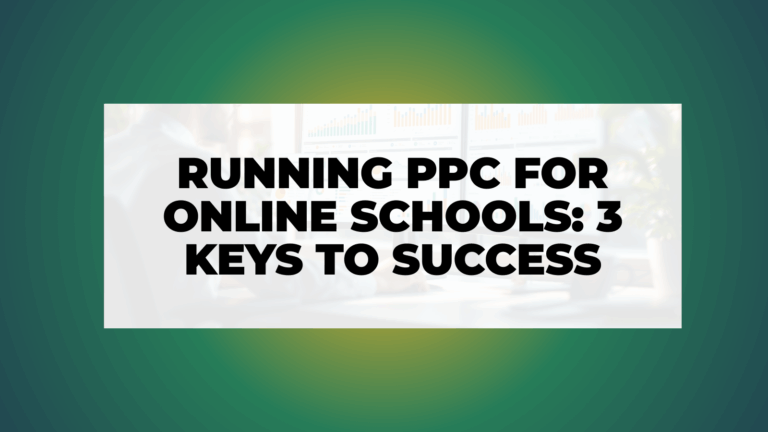Why Smart Educators Are Struggling With Marketing
Here’s an uncomfortable truth: most online school marketing is built backward. Schools owners are experts at creating powerful learning experiences, but they often find themselves lost in marketing efforts that feel disorganized and costly. We hear a familiar story from founders—they are brilliant, motivated, and deeply believe in their programs, tech, and course instructors yet their marketing campaigns fail to bring in a steady stream of students.
The problem isn’t a lack of passion or investment. It’s a misaligned focus. Many schools get caught up chasing vanity metrics like social media likes and form submissions. These activities feel productive, but they don’t directly translate into paid enrollments.
The Three Critical Blind Spots
This common struggle can be traced back to three foundational gaps that turn promising marketing campaigns into expensive lessons. Instead of creating a system that reliably generates enrollments, many educators accidentally build one that leaks both money and opportunity. These blind spots are:
- Operating in the Dark: Running campaigns without proper conversion tracking is like trying to drive to a different country without a GPS. You’re moving, but you have no real idea if you’re getting closer to your destination or just drifting further off course.
- Chaotic Campaign Structures: When ad accounts are a mess, your budget gets wasted on underperforming ads. The platform’s algorithms can’t learn and optimize properly, and you’re left guessing which campaigns are actually working.
- Disconnected Messaging: A potential student clicks an ad promising a complete career change but lands on a generic page listing course modules. This jarring transition creates confusion and kills their interest before they even have a chance to convert.
Pillar 1: Tracking Conversions That Matter For Growth
Successful online school marketing starts with a fundamental shift in focus: stop counting clicks and impressions and start measuring the actions that actually lead to new students. Running ads without this pillar is like trying to fix an engine by only looking at the speedometer. You can see you’re moving, but you have no idea what’s making the car go. This is why conversion tracking is the first and most critical part of your growth plan.
Think of your marketing funnel as a relay race where each hand-off is a crucial step. A potential student rarely sees an ad and immediately enrolls. Instead, they might download a syllabus, book a consultation call, or sign up for a free trial class first. Each of these actions is a micro-conversion—a clear signal that their interest is growing. Your job is to track these moments accurately. Without this data, you’re just guessing where to put your budget, unable to tell which campaigns attract qualified leads and which ones just bring in casual window shoppers.
📌Resource: Conversions Measurement Guide to Finally Make Sense of Your Data
Defining Your Key Performance Actions
Your first step is to map out the specific actions a prospect takes on their journey to becoming a student. These are your true measures of performance. For most online schools, the key conversions to track are:
- Leads: When someone submits a form to get an info packet, downloads a course syllabus, or signs up for a webinar.
- Bookings: When a prospect schedules an admissions call or a one-on-one discovery session.
- Trials: When a user signs up for a free introductory module or a limited-time trial of your learning platform.
- Enrollments: The ultimate goal—a completed application and paid tuition.
To help you organize this, here’s a breakdown of the most common conversion events, their business impact, and how to prioritize tracking them.
| Conversion Event | Business Impact | Tracking Method | Optimization Priority |
|---|---|---|---|
| Syllabus Download | Identifies prospects with high interest in a specific course. | Track form submissions or button clicks via Google Tag Manager. | High |
| Booked Consultation | Captures highly qualified leads ready for a sales conversation. | Track “Thank You” page views after a booking is confirmed. | High |
| Free Trial Signup | Allows prospects to experience the product, increasing enrollment likelihood. | Track sign-up form completions and user registrations. | Medium |
| Enrollment (Purchase) | The final goal; directly generates revenue and proves ROI. | Track e-commerce transaction events with purchase values. | Critical |
Tracking these specific events gives you a clear picture of what’s working. You can see which channels don’t just deliver leads, but deliver leads that turn into paying students. This insight is what allows you to make smart budget decisions, scaling up what works and cutting what doesn’t.
Pillar 2: Campaign Structure That Scales Profitably
Now that your conversion tracking is working correctly, it’s time to build the second pillar: a logical ad account structure. Imagine your ad account is a library. If books are just shoved onto shelves at random, finding what you need is nearly impossible. But when organized by genre, author, and topic, anyone can quickly locate a specific title. A messy ad account creates the same kind of chaos, making it hard for both you and the ad platform’s algorithms to identify what works. This disorganization leads to wasted ad spend and stalls your online school marketing efforts.
A clean structure separates your audiences and messages, which allows for clear performance analysis and smarter budget allocation. This is essential for scaling your school’s growth.
Prospecting vs. Remarketing Campaigns
The most critical separation you can make in your account is between prospecting and remarketing.
- Prospecting Campaigns: These ads target cold audiences—people who have likely never heard of your online school before. The goal here is to cast a wide net, generate awareness, and create initial interest.
- Remarketing Campaigns: These ads target warm audiences—people who have already interacted with you by visiting your site, watching a video, or downloading a syllabus. The goal is to re-engage these potential students and guide them toward enrollment.
By separating them, you can assign specific budgets and create tailored messages for each stage of the student’s journey.
Structuring by Intent and Program
Beyond the prospecting and remarketing split, you should also organize campaigns by your course offerings or a potential student’s intent. For instance, create separate campaigns for a “Certificate in Data Analytics” and a “Beginner’s Guide to UX Design.”
This approach lets you customize your ads and landing pages for each program, ensuring your message directly matches what each student segment is searching for. This level of detail transforms scattered ad spending into a predictable, scalable enrollment engine.
Pillar 3: Message Alignment That Converts Prospects
Now that your tracking is clean and your campaigns are organized, it’s time for the final piece of the puzzle: message alignment. This is where your ads and landing pages work in perfect harmony to guide potential students from curiosity to enrollment. The most expensive mistake you can make is to promise one thing in an ad and show something completely different on the page they click through to. This disconnect causes confusion, breaks trust, and sends interested prospects heading for the exit.
Think of it like a conversation. Your ad starts the dialogue by tapping into a specific need or goal. Your landing page must continue that exact conversation, not abruptly change the subject.
Matching Copy to Student Intent
To achieve this alignment, you need to match your words to a student’s specific goal. Are they a career changer who needs a comprehensive program, or a professional looking to add a specific skill to their resume? Your messaging needs to speak directly to them.
- For Career Changers: Your ad might promise a new career path or highlight job outcomes. The landing page should immediately back this up with student success stories, graduate placement rates, and clear details about how the program achieves those results.
- For Skill Upgraders: Your ad could feature a specific, in-demand certification. The landing page must then instantly provide the course details, duration, and the direct value of earning that credential.
Getting this right is crucial for turning clicks into sign-ups. Honing your messaging builds trust and makes the decision to enroll feel natural and logical. Learning about effective website copywriting tips can give you the tools to craft content that connects with prospects and improves your enrollment rates.
Building Your Enrollment Growth Engine
Success in online school marketing isn’t about finding a single magic bullet; it’s about building a reliable system that consistently improves over time. Think of it as an engine. Your three pillars—tracking, structure, and messaging—are the core components that work together to drive sustainable growth. This system shifts you from guessing what works to knowing with certainty, giving you the confidence to scale your school.
The core idea is simple: your marketing should be clear, measurable, and laser-focused on actual enrollments, not just clicks or impressions.
Your Next Steps to Sustainable Growth
Start by looking at your current marketing efforts through the lens of this framework. Are you measuring the right conversions? Is your campaign structure organized and easy to understand? Does your messaging truly speak to your ideal student?
From there, focus on making small, deliberate adjustments and see your results improve.
Tired of chaotic marketing that burns through your budget? At nn.partners, we implement this exact three-pillar system to bring clarity to your ads, drive enrollments, and give you your freedom back. Let’s build your growth engine together – get in touch!



